TOYOTA 86 2017 Repair Manual
Manufacturer: TOYOTA, Model Year: 2017, Model line: 86, Model: TOYOTA 86 2017Pages: 428, PDF Size: 5.25 MB
Page 61 of 428
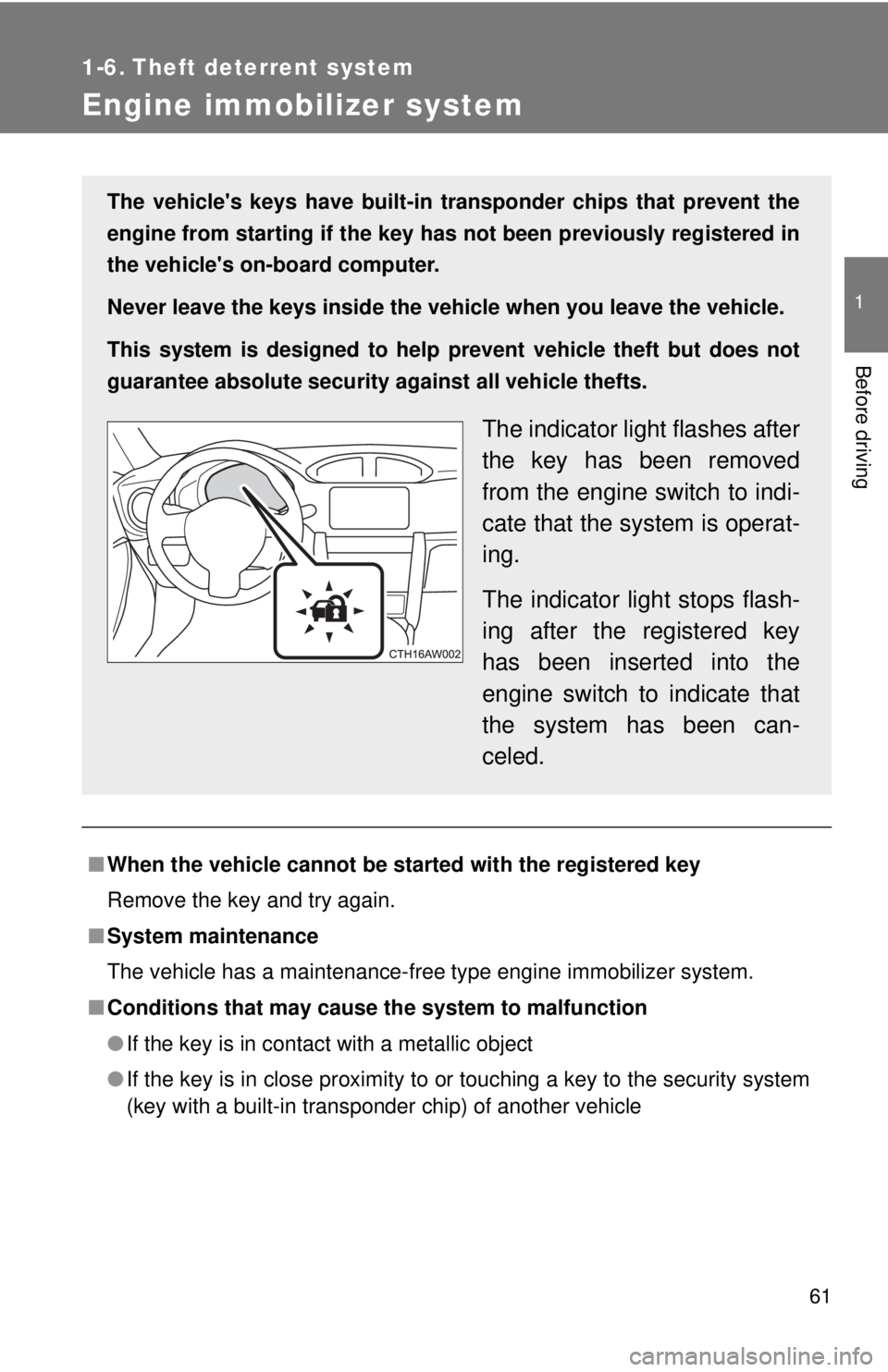
61 1
Before driving 1-6. Theft deterrent system
Engine immobilizer system
■ When the vehicle cannot be started with the registered key
Remove the key and try again.
■ System maintenance
The vehicle has a maintenance-free type engine immobilizer system.
■ Conditions that may cause the system to malfunction
● If the key is in contact with a metallic object
● If the key is in close proximity to or touching a key to the security system
(key with a built-in transponder chip) of another vehicleThe vehicle's keys have built-in tran sponder chips that prevent the
engine from starting if the key has not been previously registered in
the vehicle's on-board computer.
Never leave the keys inside the vehicle when you leave the vehicle.
This system is designed to help prevent vehicle theft but does not
guarantee absolute security against all vehicle thefts.
The indicator light flashes after
the key has been removed
from the engine switch to indi-
cate that the system is operat-
ing.
The indicator light stops flash-
ing after the registered key
has been inserted into the
engine switch to indicate that
the system has been can-
celed.
Page 62 of 428

621-6. Theft deterrent system
■ Certification for engi ne immobilizer system
For vehicles sold in the U.S.A.
FCC ID: MOZRI-38BFH
This device complies with part 15 of the FCC Rules. Operation is subject to
the following two conditions: (1) This device may not cause harmful interfer-
ence, and (2) this device must accept any interference received, including
interference that may cause undesired operation.
FCC WARNING
Changes or modifications not expressly approved by the party responsible
for compliance could void the user’s authority to operate the equipment.
For vehicles sold in Canada
NOTE:
This device complies with Industry Canada’s licence-exempt RSSs. Opera-
tion is subject to the following two conditions: (1) This device may not cause
interference, and (2) This device must accept any interference, including
interference that may cause undesired operation of the device.
NOTE:
Le présent appareil est conforme aux CNR d’Industrie Canada applicables
aux appareils radio exempts de licence. L’exploitation est autorisée aux
deux conditions suivantes: (1) l’appareil ne doit pas produire de brouillage;
(2) l’utilisateur de l’appareil doit accepter tout brouillage radioélectrique subi,
même si le brouillage est susceptible d’en compromettre le fonctionnement.
NOTICE
■ To ensure the system operates correctly
Do not modify or remove the system. If modified or removed, the proper
operation of the system cannot be guaranteed.
Page 63 of 428
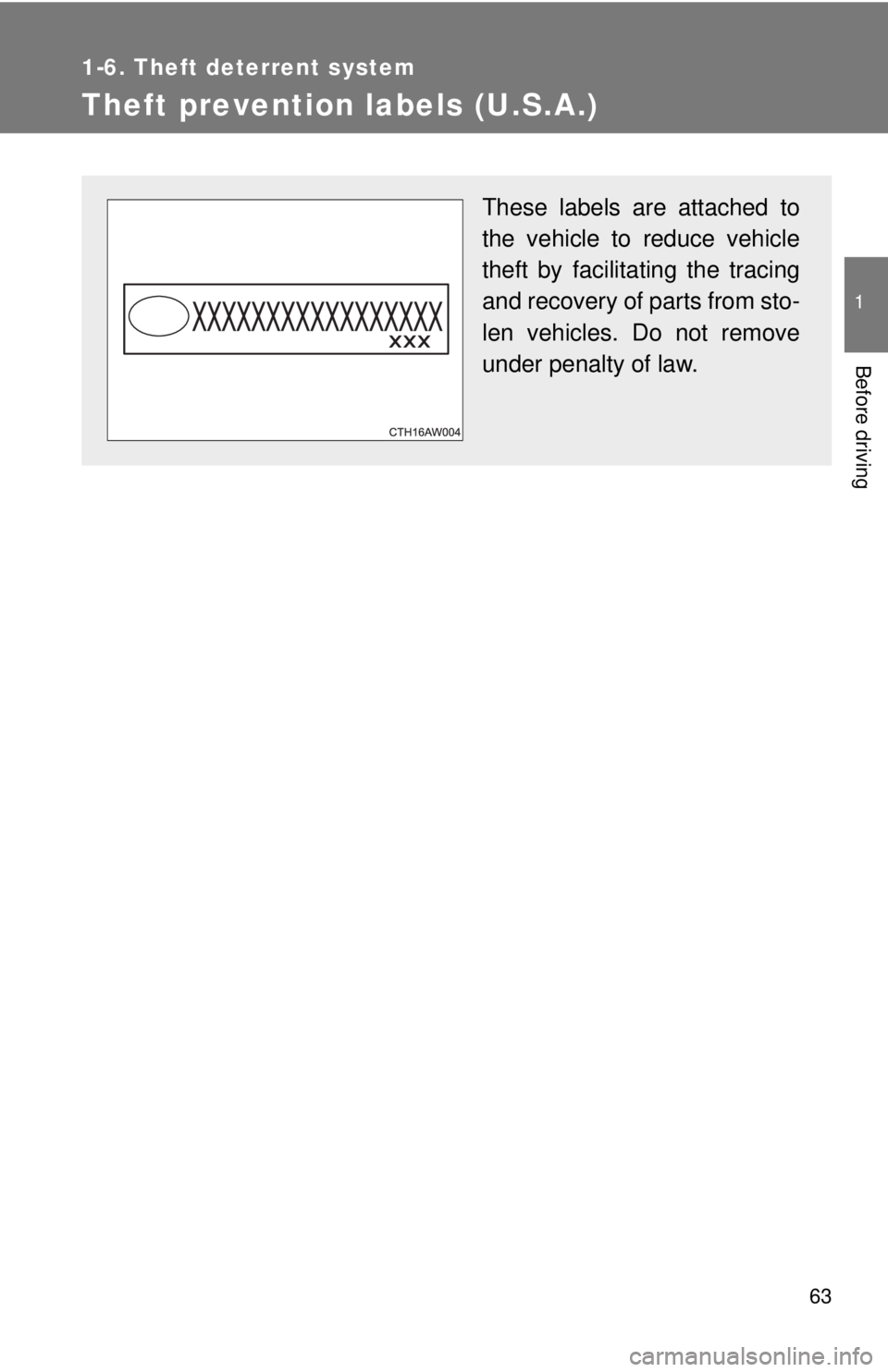
63 11-6. Theft deterrent system
Before driving
Theft prevention labels (U.S.A.) These labels are attached to
the vehicle to reduce vehicle
theft by facilitat ing the tracing
and recovery of parts from sto-
len vehicles. Do not remove
under penalty of law.
Page 64 of 428
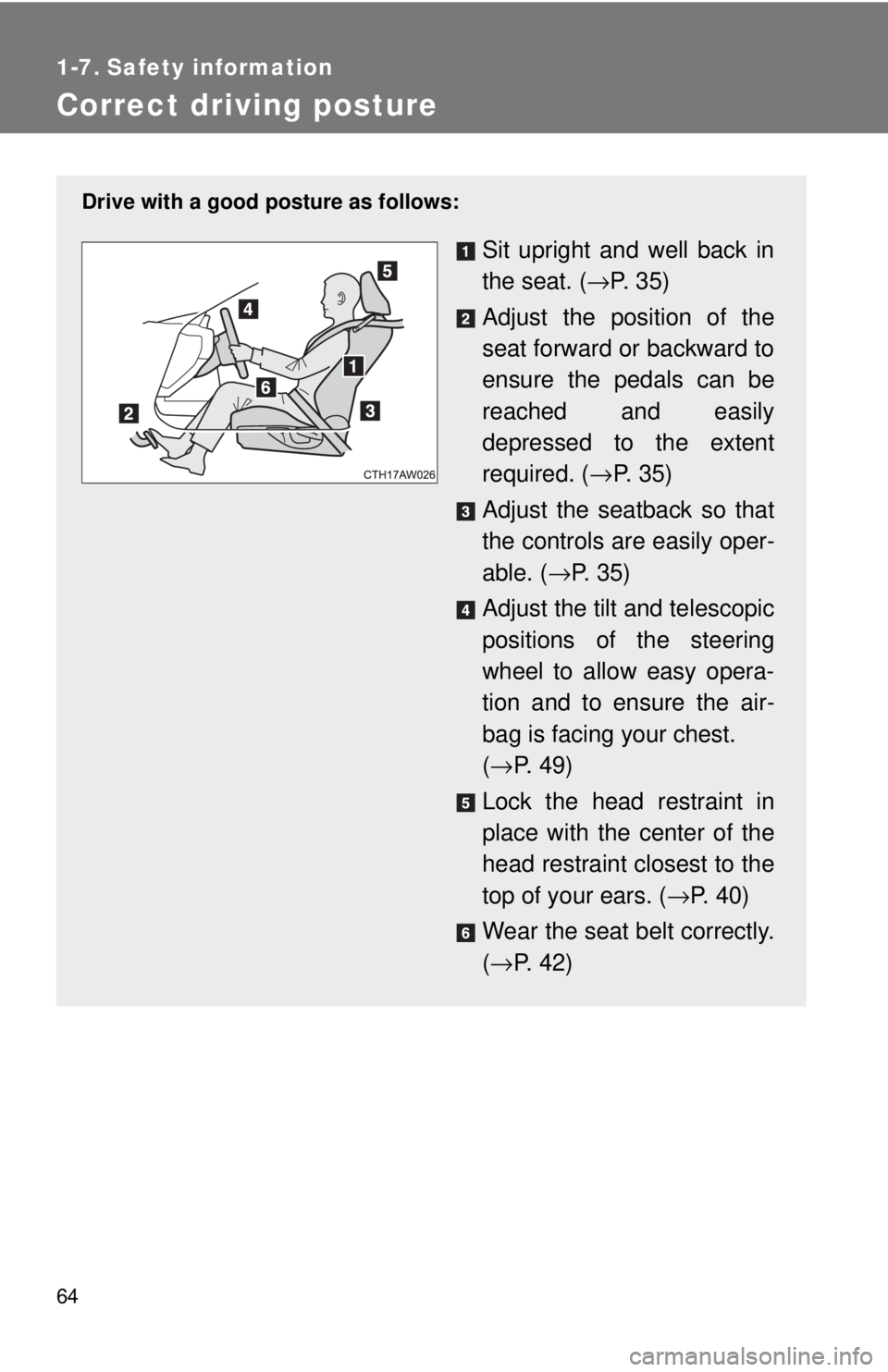
641-7. Safety information
Correct driving posture Drive with a good posture as follows:
Sit upright and well back in
the seat. ( → P. 3 5 )
Adjust the position of the
seat forward or backward to
ensure the pedals can be
reached and easily
depressed to the extent
required. ( → P. 35)
Adjust the seatback so that
the controls are easily oper-
able. ( → P. 35)
Adjust the tilt and telescopic
positions of the steering
wheel to allow easy opera-
tion and to ensure the air-
bag is facing your chest.
( → P. 49)
Lock the head restraint in
place with the center of the
head restraint closest to the
top of your ears. ( → P. 40)
Wear the seat belt correctly.
( → P. 42)
Page 65 of 428

651-7. Safety information
1
Before driving WARNING■ While driving
● Do not adjust the position of the driver's seat.
Doing so could cause the driver to lose control of the vehicle.
● Do not place a cushion between the driver or passenger and the seatback.
A cushion may prevent correct posture from being achieved, and reduce
the effectiveness of the seat belt and head restraint, increasing the risk of
death or serious injury to the driver or passenger.
● Do not place anything under the front seats.
Objects placed under the front seats may become jammed in the seat
tracks and stop the seat from locking in place. This may lead to an acci-
dent resulting in serious injury or death. The adjustment mechanism may
also be damaged.
■ Adjusting the seat position
● Take care when adjusting the seat position to ensure that other passen-
gers are not injured by the moving seat.
● Do not put your hands under the seat or near the moving parts to avoid
injury.
Fingers or hands may become jammed in the seat mechanism.
Page 66 of 428

661-7. Safety information
SRS airbag (Supplemental Restraint System airbag)The SRS airbags inflat e when the vehicle is subjected to certain
types of severe impacts that may cause significant injury to the
occupants. They work together with the seat belts to help reduce the
risk of death or serious injury.
SRS: This stands for supplement al restraint system. This name is
used because the airbag system supplements the vehicle’s seat
belts.
Models with SRS airbags and se at belts for driver, front pas-
senger, and rear passengers
Your vehicle is equipped with a s upplemental rest raint system in
addition to a seat belt at each fr ont seating positions and each rear
seating positions. The supplementa l restraint system (SRS) con-
sists of six airbags. The c onfigurations are as follows.
Page 67 of 428
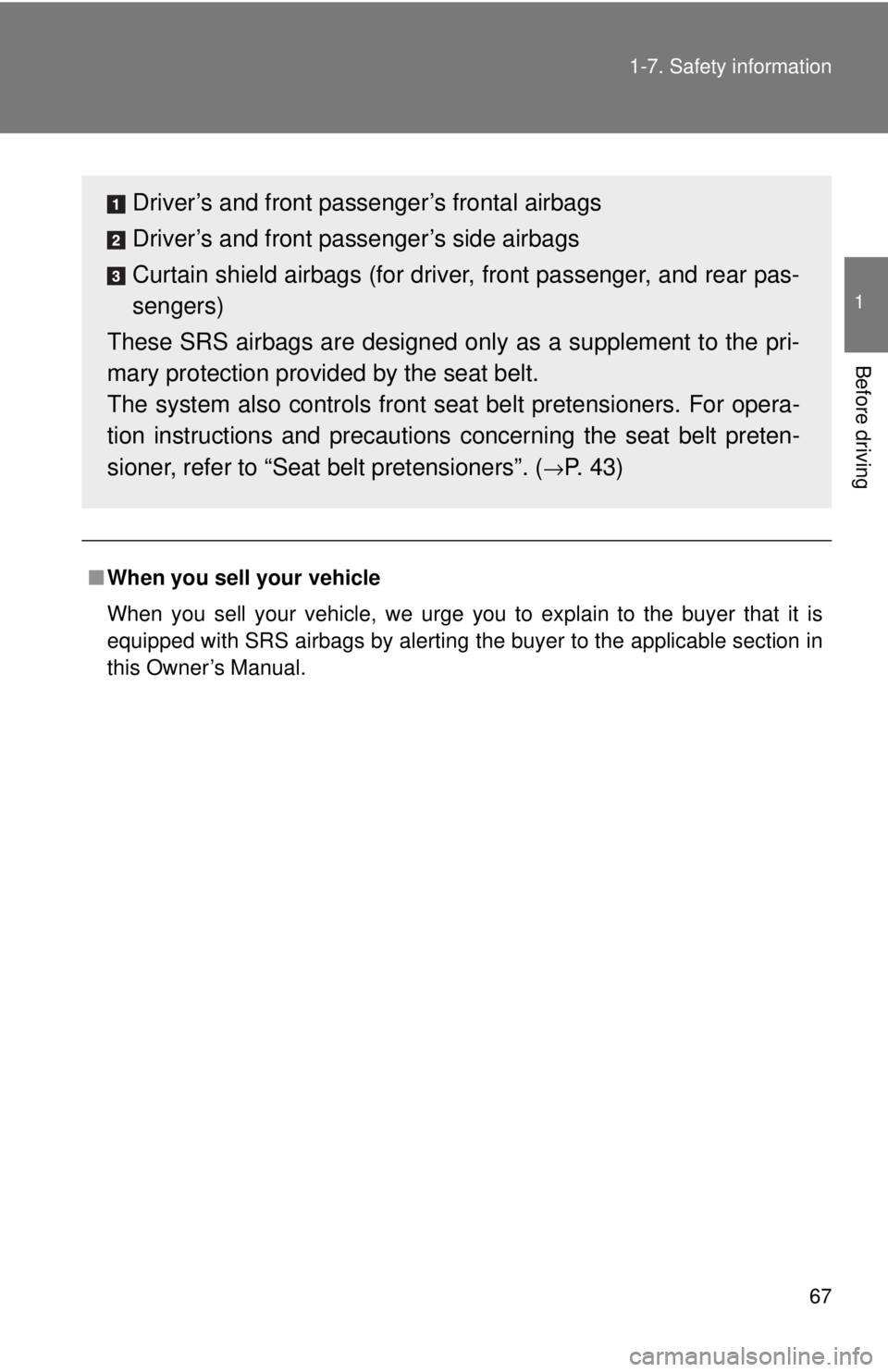
671-7. Safety information
1
Before driving
■ When you sell your vehicle
When you sell your vehicle, we urge you to explain to the buyer that it is
equipped with SRS airbags by alerting t he buyer to the applicable section in
this Owner’s Manual. Driver’s and front passenger’s frontal airbags
Driver’s and front passenger’s side airbags
Curtain shield airbags (for driver, front passenger, and rear pas-
sengers)
These SRS airbags are designed only as a supplement to the pri-
mary protection provid ed by the seat belt.
The system also controls front s eat belt pretensioners. For opera-
tion instructions and precautions concerning the seat belt preten-
sioner, refer to “Seat belt pretensioners”. ( →
P. 43)
Page 68 of 428

681-7. Safety information
WARNING■ SRS airbag
● To obtain maximum protection in the event of an accident, the driver and
all passengers in the vehicle should always wear seat belts when the vehi-
cle is moving. The SRS airbag is designed only to be a supplement to the
primary protection provided by the seat belt. It does not eliminate the need
to fasten seat belts. In combination with the seat belts, it offers the best
combined protection in case of a serious accident.
Not wearing a seat belt increases the chance of severe injury or death in a
crash even when the vehicle has the SRS airbag.
For instructions and precautions concerning the seat belt system, refer to
“Seat belts”. ( → P. 42)
● Do not sit or lean unnecessarily close to the SRS airbag. Because the
SRS airbag deploys with considerable speed - faster than the blink of an
eye - and force to protect in high speed collisions, the force of an airbag
can injure an occupant whose body is too close to SRS airbag.
It is also important to wear your seat belt to help avoid injuries that can
result when the SRS airbag contacts an occupant not in proper position
such as one thrown forward during pre-accident braking.
Even when properly positioned, there remains a possibility that an occu-
pant may suffer minor injury such as abrasions and bruises to the face or
arms because of the SRS airbag deployment force.
● The SRS airbags deploy with considerable speed and force. Occupants
who are out of proper position when the SRS airbag deploys could suffer
very serious injuries. Because the SRS airbag needs enough space for
deployment, the driver should always sit upright and well back in the seat
as far from the steering wheel as practical while still maintaining full vehi-
cle control and the front passenger should move the seat as far back as
possible and sit upright and well back in the seat.
● Do not place any objects over or near the SRS airbag cover or between
you and the SRS airbag. If the SRS airbag deploys, those objects could
interfere with its proper operation and could be propelled inside the vehicle
and cause injury.
Page 69 of 428
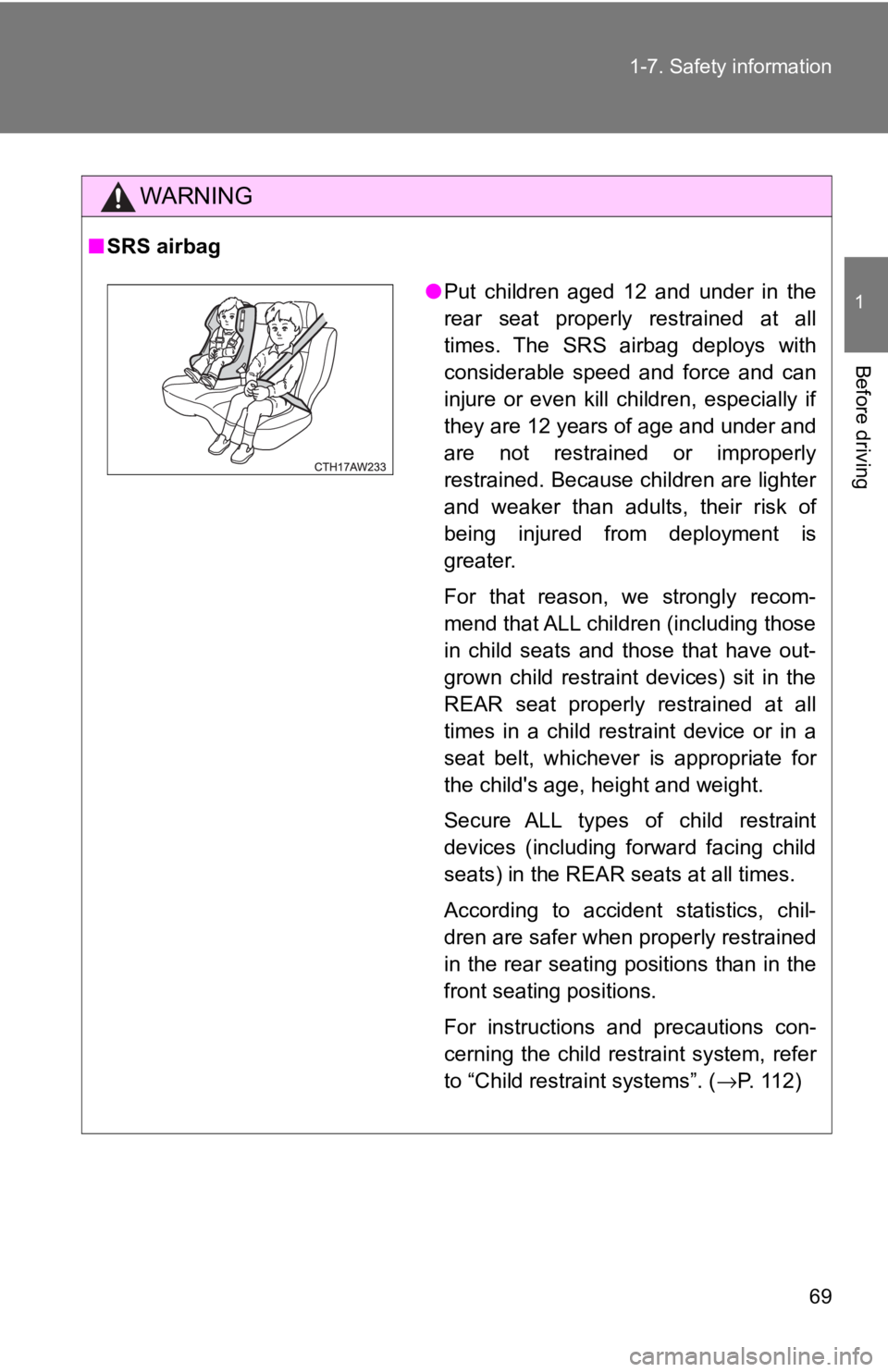
691-7. Safety information
1
Before driving WARNING■ SRS airbag
● Put children aged 12 and under in the
rear seat properly restrained at all
times. The SRS airbag deploys with
considerable speed and force and can
injure or even kill children, especially if
they are 12 years of age and under and
are not restrained or improperly
restrained. Because children are lighter
and weaker than adults, their risk of
being injured from deployment is
greater.
For that reason, we strongly recom-
mend that ALL children (including those
in child seats and those that have out-
grown child restraint devices) sit in the
REAR seat properly restrained at all
times in a child restraint device or in a
seat belt, whichever is appropriate for
the child's age, height and weight.
Secure ALL types of child restraint
devices (including forward facing child
seats) in the REAR seats at all times.
According to accident statistics, chil-
dren are safer when properly restrained
in the rear seating positions than in the
front seating positions.
For instructions and precautions con-
cerning the child restraint system, refer
to “Child restraint systems”. ( → P. 112)
Page 70 of 428

701-7. Safety information
WARNING■ SRS airbag
● NEVER INSTALL A REARWARD FACING CHILD SEAT IN THE FRONT
SEAT. DOING SO RISKS SERIOUS INJURY OR DEATH TO THE CHILD
BY PLACING THE CHILD’S HEAD TOO CLOSE TO THE SRS AIRBAG.
● Never allow a child to stand up, or to kneel on the front passenger’s seat,
or never hold a child on your lap or in your arms. The SRS airbag deploys
with considerable force and can injure or even kill the child.
● When the SRS airbag deploys, some smoke will be released. This smoke
could cause breathing problems for people with a history of asthma or
other breathing trouble. If you or your passengers have breathing prob-
lems after SRS airbag deploys, get fresh air promptly.
● A deploying SRS airbag releases hot gas. Occupants could get burned if
they come into direct contact with the hot gas.